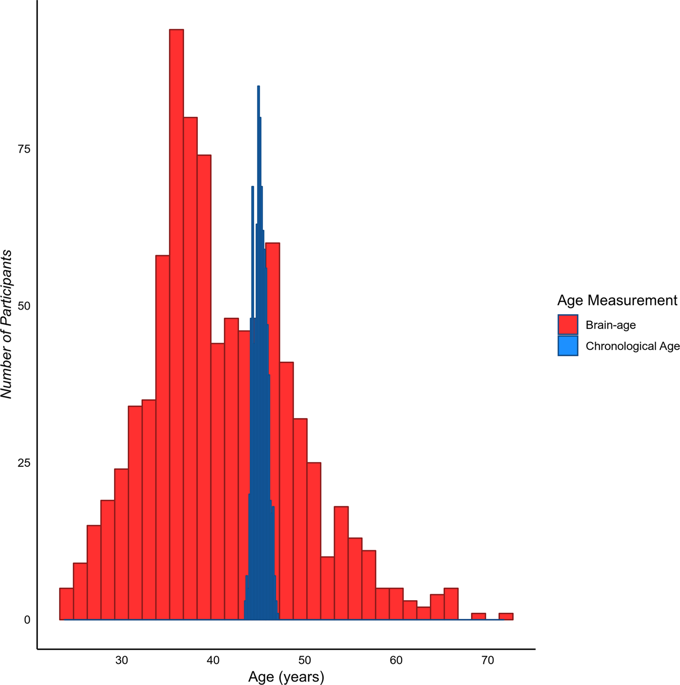当前位置:
X-MOL 学术
›
Mol. Psychiatry
›
论文详情
Our official English website, www.x-mol.net, welcomes your
feedback! (Note: you will need to create a separate account there.)
Brain-age in midlife is associated with accelerated biological aging and cognitive decline in a longitudinal birth cohort.
Molecular Psychiatry ( IF 9.6 ) Pub Date : 2019-12-10 , DOI: 10.1038/s41380-019-0626-7 Maxwell L Elliott 1 , Daniel W Belsky 2, 3 , Annchen R Knodt 1 , David Ireland 4 , Tracy R Melzer 5, 6 , Richie Poulton 4 , Sandhya Ramrakha 4 , Avshalom Caspi 1, 7, 8, 9 , Terrie E Moffitt 1, 7, 8, 9 , Ahmad R Hariri 1
Molecular Psychiatry ( IF 9.6 ) Pub Date : 2019-12-10 , DOI: 10.1038/s41380-019-0626-7 Maxwell L Elliott 1 , Daniel W Belsky 2, 3 , Annchen R Knodt 1 , David Ireland 4 , Tracy R Melzer 5, 6 , Richie Poulton 4 , Sandhya Ramrakha 4 , Avshalom Caspi 1, 7, 8, 9 , Terrie E Moffitt 1, 7, 8, 9 , Ahmad R Hariri 1
Affiliation

|
An individual's brainAGE is the difference between chronological age and age predicted from machine-learning models of brain-imaging data. BrainAGE has been proposed as a biomarker of age-related deterioration of the brain. Having an older brainAGE has been linked to Alzheimer's, dementia, and mortality. However, these findings are largely based on cross-sectional associations which can confuse age differences with cohort differences. To illuminate the validity of brainAGE as a biomarker of accelerated brain aging, a study is needed of a large cohort all born in the same year who nevertheless vary on brainAGE. In the Dunedin Study, a population-representative 1972-73 birth cohort, we measured brainAGE at age 45 years, as well as the pace of biological aging and cognitive decline in longitudinal data from childhood to midlife (N = 869). In this cohort, all chronological age 45 years, brainAGE was measured reliably (ICC = 0.81) and ranged from 24 to 72 years. Those with older midlife brainAGEs tended to have poorer cognitive function in both adulthood and childhood, as well as impaired brain health at age 3. Furthermore, those with older brainAGEs had an accelerated pace of biological aging, older facial appearance, and early signs of cognitive decline from childhood to midlife. These findings help to validate brainAGE as a potential surrogate biomarker for midlife intervention studies that seek to measure dementia-prevention efforts in midlife. However, the findings also caution against the assumption that brainAGE scores represent only age-related deterioration of the brain as they may also index central nervous system variation present since childhood.
中文翻译:

中年时期的大脑年龄与纵向出生队列中生物衰老加速和认知能力下降有关。
个人的 BrainAGE 是实际年龄与根据大脑成像数据的机器学习模型预测的年龄之间的差异。 BrainAGE 已被提议作为与年龄相关的大脑退化的生物标志物。年龄较大的 BrainAGE 与阿尔茨海默病、痴呆症和死亡率有关。然而,这些发现很大程度上基于横截面关联,这可能会混淆年龄差异与队列差异。为了阐明 BrainAGE 作为大脑加速老化生物标志物的有效性,需要对一大群同一年出生的人进行研究,但他们的 BrainAGE 存在差异。在达尼丁研究(具有代表性的 1972-73 出生队列)中,我们测量了 45 岁时的 BrainAGE,以及从童年到中年的纵向数据中的生物衰老和认知能力下降的速度 (N = 869)。在该队列中,所有实际年龄均为 45 岁,brainAGE 得到可靠测量(ICC = 0.81),年龄范围为 24 至 72 岁。中年 BrainAGE 年龄较大的人在成年和儿童时期的认知功能往往较差,并且在 3 岁时大脑健康受损。此外,BrainAGE 年龄较大的人生物衰老速度加快,面部外观老化,并出现早期认知迹象。从童年到中年逐渐衰退。这些发现有助于验证 BrainAGE 作为中年干预研究的潜在替代生物标志物,这些研究旨在衡量中年痴呆症预防工作。然而,研究结果也提醒人们不要认为 BrainAGE 分数仅代表与年龄相关的大脑退化,因为它们也可能反映了自童年以来就存在的中枢神经系统变化。
更新日期:2019-12-11
中文翻译:

中年时期的大脑年龄与纵向出生队列中生物衰老加速和认知能力下降有关。
个人的 BrainAGE 是实际年龄与根据大脑成像数据的机器学习模型预测的年龄之间的差异。 BrainAGE 已被提议作为与年龄相关的大脑退化的生物标志物。年龄较大的 BrainAGE 与阿尔茨海默病、痴呆症和死亡率有关。然而,这些发现很大程度上基于横截面关联,这可能会混淆年龄差异与队列差异。为了阐明 BrainAGE 作为大脑加速老化生物标志物的有效性,需要对一大群同一年出生的人进行研究,但他们的 BrainAGE 存在差异。在达尼丁研究(具有代表性的 1972-73 出生队列)中,我们测量了 45 岁时的 BrainAGE,以及从童年到中年的纵向数据中的生物衰老和认知能力下降的速度 (N = 869)。在该队列中,所有实际年龄均为 45 岁,brainAGE 得到可靠测量(ICC = 0.81),年龄范围为 24 至 72 岁。中年 BrainAGE 年龄较大的人在成年和儿童时期的认知功能往往较差,并且在 3 岁时大脑健康受损。此外,BrainAGE 年龄较大的人生物衰老速度加快,面部外观老化,并出现早期认知迹象。从童年到中年逐渐衰退。这些发现有助于验证 BrainAGE 作为中年干预研究的潜在替代生物标志物,这些研究旨在衡量中年痴呆症预防工作。然而,研究结果也提醒人们不要认为 BrainAGE 分数仅代表与年龄相关的大脑退化,因为它们也可能反映了自童年以来就存在的中枢神经系统变化。











































 京公网安备 11010802027423号
京公网安备 11010802027423号